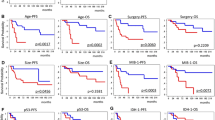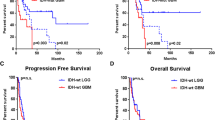Abstract
Astrocytic tumours often become resistant to a variety of chemotherapeutic agents in advanced stages and frequently possess mutations in the p53 tumour-suppressor gene. Previous studies using established cell lines to investigate the relation between mutated p53 genes and altered resistance to anti-cancer agents brought inconsistent results. In this report, we examined the status of the p53 gene in 56 astrocytic tumour specimens by single-strand conformation polymorphism and their in vitro chemosensitivity to 30 different kinds of anti-cancer agents. The chemosensitivity was determined by drug-induced cell death using flow cytometry. We found that the mutated p53 gene correlated with increased resistance to DNA-damaging agents but the sensitivity to anti-microtubule agents was independent of the mutation, suggesting a clinical significance of the status of p53 gene in astrocytic tumours and a rational application of anti-microtubule agents to the patients with p53-mutated astrocytic tumours.
Similar content being viewed by others
Author information
Authors and Affiliations
Rights and permissions
About this article
Cite this article
Iwadate, Y., Tagawa, M., Fujimoto, S. et al. Mutation of the p53 gene in human astrocytic tumours correlates with increased resistance to DNA-damaging agents but not to anti-microtubule anti-cancer agents. Br J Cancer 77, 547–551 (1998). https://doi.org/10.1038/bjc.1998.88
Issue Date:
DOI: https://doi.org/10.1038/bjc.1998.88
- Springer Nature Limited
This article is cited by
-
Wild-type and mutant p53 differentially modulate miR-124/iASPP feedback following pohotodynamic therapy in human colon cancer cell line
Cell Death & Disease (2017)
-
Synergistic interaction between tetrandrine and chemotherapeutic agents and influence of tetrandrine on chemotherapeutic agent-associated genes in human gastric cancer cell lines
Cancer Chemotherapy and Pharmacology (2007)
-
Sensitizing glioma cells to cisplatin by abrogating the p53 response with antisense oligonucleotides
Cancer Gene Therapy (2004)
-
Hyperthermia induces translocation of apoptosis-inducing factor (AIF) and apoptosis in human glioma cell lines
Journal of Neuro-Oncology (2004)
-
Promising survival for patients with glioblastoma multiforme treated with individualised chemotherapy based on in vitro drug sensitivity testing
British Journal of Cancer (2003)




